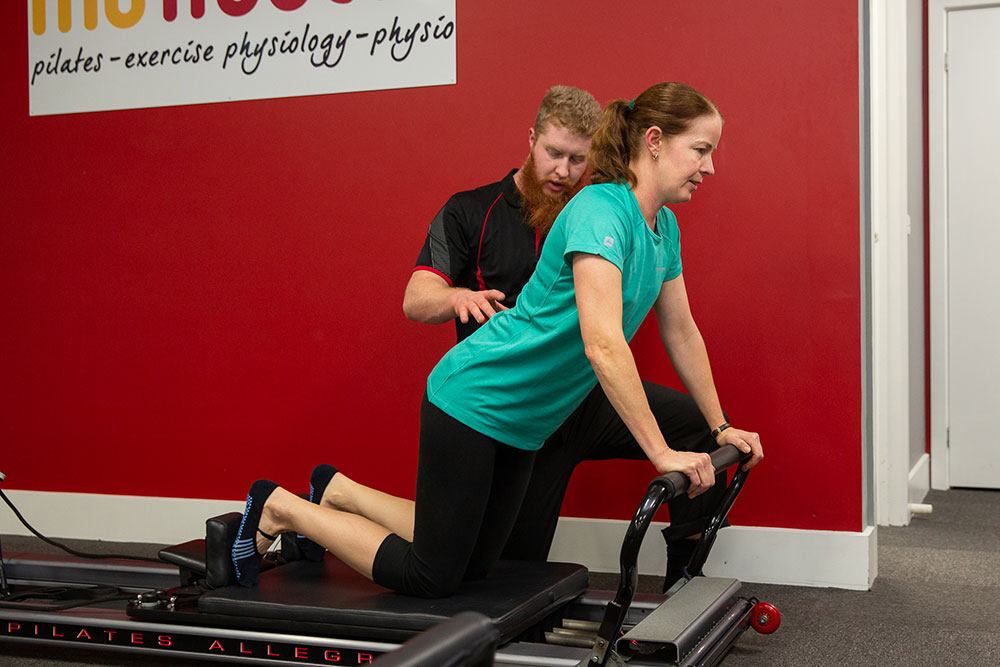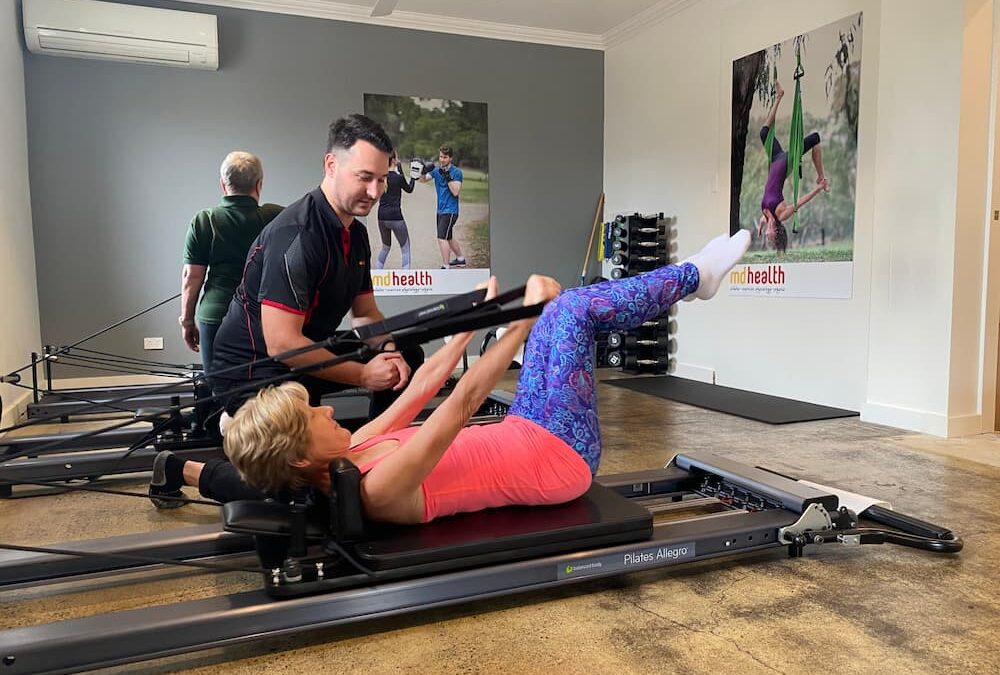If you’re interested in learning more about Pilates, you’ve come to the right place! Today, we’re going to explore the fascinating world of Pilates and its potential to tone your body.
In this blog post, we’ll discuss what toning means in the context of physical fitness, the benefits of Pilates for toning, the science behind it, and how Pilates compares to other popular forms of exercise. We’ll also offer tips for maximising your toning results with Pilates. Let’s get started!
The Definition of Toning
In the realm of fitness, “toning” generally refers to the process of increasing muscle definition and reducing excess body fat. This creates a more sculpted and lean appearance.
Pilates, a form of exercise that emphasizes controlled movements, breath, and alignment, can indeed contribute to toning your body.
By targeting specific muscle groups and engaging your core, Pilates can help you develop long, lean muscles and improve overall body composition.
The Benefits of Pilates for Toning
One of the most significant benefits of Pilates is that it can improve your muscle strength. Pilates focuses on working your core muscles, including your abdominal muscles, lower back muscles, and hip muscles.
Strengthening these muscles can improve your overall muscular strength and help you maintain better balance and stability. With consistent practice, you can expect to see noticeable toning in your abdominal area and throughout your body.
Another benefit of Pilates is that it can enhance your flexibility. Pilates exercises involve slow, controlled movements that help improve your range of motion and elongate your muscles. This can help create a toned and lean appearance in your muscles. With regular practice, you can expect to become more flexible and feel less stiff.
Pilates also emphasizes proper body alignment, which can lead to better posture. Poor posture can contribute to back pain and make you appear shorter and less toned.
With Pilates, you’ll learn how to align your body properly, which can make you appear taller and more toned. This can have a significant impact on your overall appearance and confidence.
Also, Pilates can improve your body awareness. By practicing Pilates, you’ll become more in tune with your muscles and movement patterns. This increased awareness can help you engage the right muscles for a more effective workout and better toning results.
You’ll also become more mindful of your body throughout the day, which can help you maintain good posture and avoid injury.

The Science Behind Pilates and Toning
Here are three great studies focusing on the science behind Pilates and toning, specifically targeting physiotherapists:
Cruz-Ferreira, A., Fernandes, J., Laranjo, L., Bernardo, L. M., & Silva, A. (2011). A systematic review of the effects of Pilates method of exercise in healthy people. Archives of Physical Medicine and Rehabilitation, 92(12), 2071-2081. doi: 10.1016/j.apmr.2011.06.023
This systematic review investigates the effects of Pilates on healthy individuals, including improvements in muscle strength, toning, and flexibility. The authors highlight the growing interest of physiotherapists in using Pilates as an adjunct to traditional rehabilitation practices.
The review also discusses the potential benefits of Pilates for individuals with various medical conditions, suggesting its applicability in the field of physiotherapy.
Wells, C., Kolt, G. S., & Bialocerkowski, A. (2012). Defining Pilates exercise: A systematic review. Complementary Therapies in Medicine, 20(4), 253-262. doi: 10.1016/j.ctim.2012.02.005
This systematic review aims to define Pilates exercise and identify its core components, making it easier for physiotherapists and other practitioners to implement the method into their practice. The authors analyze various studies to determine the key principles and techniques of Pilates.
They conclude that Pilates is an effective exercise modality for improving muscle tone, strength, and flexibility, which are crucial aspects of rehabilitation and injury prevention in physiotherapy.
Latey, P. (2001). The Pilates method: History and philosophy. Journal of Bodywork and Movement Therapies, 5(4), 275-282. doi: 10.1054/jbmt.2001.0237
In this study, the author provides a comprehensive overview of the Pilates method, including its history and philosophy. Latey highlights the effectiveness of Pilates in addressing the needs of both healthy individuals and patients undergoing rehabilitation.
The study emphasizes the role of physiotherapists in incorporating Pilates into their practice to enhance muscle tone, flexibility, and overall physical well-being.
These studies provide valuable insights into the science behind Pilates and its effectiveness in promoting muscle toning, strength, and flexibility. They emphasize the growing interest among physiotherapists in incorporating Pilates into their practice as a complementary method to traditional rehabilitation techniques.

Pilates and Other Forms of Exercise
When it comes to toning your body, Pilates is not the only option. Weight lifting, for example, can also be effective in promoting muscle growth and fat loss. However, the two forms of exercise have different approaches.
Pilates focuses on building long, lean muscles and promoting flexibility, while weight lifting often emphasizes building larger muscles and increasing overall strength.
Depending on your personal goals and preferences, you may find that a combination of Pilates and other forms of exercise is the most effective way to achieve your desired level of toning.
Tips for Maximising Toning with Pilates
One of the most important factors in getting the most out of your Pilates practice is finding a qualified instructor who can guide you through the exercises and ensure you’re using proper form.
This is crucial for getting the best toning results and avoiding injury. So, make sure to do your research and find an instructor who is certified and experienced in Pilates.
Once you’ve found a qualified instructor, it’s important to set realistic goals for your Pilates practice. This might include attending a certain number of classes per week (ideally 2-3 sessions a week – How often should I do Pilates to get results?) or focusing on specific areas you’d like to tone.
By setting achievable goals, you’ll be more motivated to stick with your practice and see the results you’re looking for.
Consistency is also key when it comes to seeing noticeable toning results. Aim to attend Pilates classes or practice at home on a regular basis to build strength and muscle tone.
Additionally, incorporating cardiovascular exercise into your routine can help accelerate fat loss and complement the toning benefits of Pilates.
Of course, a balanced diet is essential for achieving a toned body. Focus on consuming whole, nutrient-dense foods that support muscle growth and fat loss.
And remember, toning your body takes time, so be patient and stay committed to your Pilates practice. With consistent effort and dedication, you’ll be amazed at the results you can achieve.
Conclusion
In conclusion, Pilates is a fantastic way to tone and strengthen your body, and by following the tips above, you can maximize your results and achieve the toned physique you’ve been striving for.
Remember to find a qualified instructor, set realistic goals, be consistent, combine Pilates with cardio, and incorporate a healthy diet into your routine. And above all, be patient and stay committed to your practice.
If you’re looking for expert guidance and personalized support to help you achieve your fitness goals with Pilates, I encourage you to consider working with the team at MD Health.
Our experienced physiotherapists, exercise physiologists and osteopaths can provide you with the individualized attention and support you need to maximize your toning results and achieve your desired level of fitness.
Whether you’re new to Pilates or an experienced practitioner, our team can help you tailor your practice to meet your unique needs and goals. So, take action today and schedule a consultation with one of our experts to start your journey to a stronger, more toned body with Pilates. Happy toning!
Do you have any questions?
Call us on (03) 9857 0644 or (07) 3505 1494 (Paddington)
Email us at admin@mdhealth.com.au
Check out our other blog posts here
Our clinical staff would be happy to have chat if you have any questions.
Take the first step to a healthier you!
Would you prefer for someone to contact you to book your FREE Full Body Assessment*?
Please fill in this form and someone from MD Health will be in touch with you soon.
Alternatively please call us on:
07 3505 1494 (Paddington – Brisbane (QLD) Clinic)
Or email us:
admin@mdhealth.com.au (VIC) paddington@mdhealth.com.au (QLD)
*Please note only the Full Body Assessment is a FREE service. The Full Body Assessment is for new clients at MD Health or returning clients who haven’t been in for 6 months or longer who intend to particpiate in our 13 Week Clinical Pilates Program**.
For all new clients who wish to come in for a one-off, casual or adhoc basis for Physiotherapy or Exercise Physiology the Initial Physiotherapy or Initial Exercise Physiology appointment is a paid service.
** The 13 Week Clinical Pilates Program at MD Health is not a lock in contract and you are not required to attend for the full 13 weeks if you do not wish.
This site is protected by reCAPTCHA and the Google Privacy Policy and Terms of Service apply.



